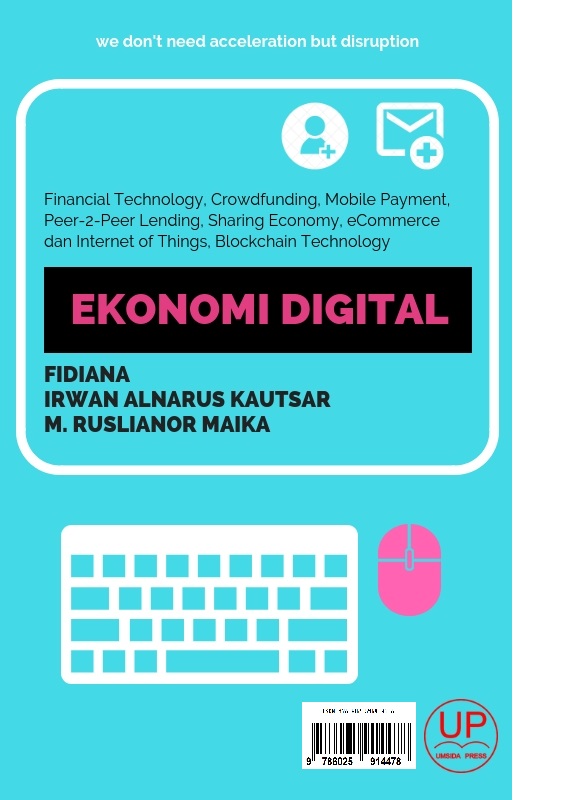Bahan Ajar Ekonomi Digital
DOI:
https://doi.org/10.21070/2018/978-602-5914-47-8Keywords:
Bahan Ajar, Ekonomi, DigitalAbstract
Laju perubahan revolusioner bidang teknologi dan penerapannya serta dampaknya, pengaruh, dan tantangannya semakin terasa. Pembuat kebijakan publik juga memiliki tantangan lebih besar dan akan memiliki masalah serius untuk ditangani. Buku ini memiliki karakteristik tersendiri yang membahas satu-persatu kegiatan industri digital saat ini. Pembahasan dalam buku ini akan menitikberatkan pada pembahasan model bisnis dari industri digital baik dari sisi konsep dan aplikasinya di masyarakat. Adapun indsutri digital yang masuk radar pembahasan kami adalah Financial Technology, Crowdfunding, Mobile Payment, Peer-2-Peer Lending, Sharing Economy, eCommerce dan Internet of Things, Blockchain Technology.
Downloads
References
Abidin, M. S. (2014). Dampak E-Money. Igarss 2014, (1), 1–5. https://doi.org/10.1007/s13398-014-0173-7.2
Adiansah, W., Mulyana, N., & Fedryansyah, M. (2002). Potensi Crowdfunding di Indonesia dalam Praktik Pekerjaan Sosial. In Prosiding KS: Riset & PKM (pp. 155–291).
Akbar, D. S. F. (2016). Konsep Crowdfunding untuk Pendanaan Infrastruktur di Indonesia. Jakarta.
Arner, D. W., Barberis, J., & Buckley, R. P. (2016a). 150 Years of Fintech: An Evolutionary Analysis. The Finsia Journal of Applied Finance, 1(3), 22–29.
Arner, D. W., Barberis, J., & Buckley, R. P. (2016b). 150 Years of Fintech: An Evolutionary Analysis. The Finsia Journal of Applied Finance, 1(3), 22–29.
Arner, D. W., Barberis, J., & Buckley, Ro. P. (2016c). The Evolution of FINTECH : A New Post-Crisis Paradigm? Georgetown Journal of International Law.
Asosiasi Fintech Indonesia. (2017). Pelaku Usaha Desak Keseriusan OJK untuk Tindak Lanjut Koordinasi Aturan Layanan P2P Lending. Retrieved from https://fintech.id/Idea%20PDF/Siaran%20Pers%20-%20Pelaku%20Usaha%20Mendesak%20Tindak%20Lanjut%20OJK%20Perihal%20P2P%20Lending%20 %2022%20Maret%202017%20FINAL.pdf
Bank Indonesia. (2016). Financial Technologies (FinTech) (pp. 1–31). Bogor: Bank Indonesia. Retrieved from http://skim.kominfo.go.id/temuilmiah/download/Sesi 1/Bank Indonesia - Materi Temu Ilmiah.pdf
Bardhi, F., & Eckhardt, G. M. (2012). Access-Based Consumption: The Case of Car Sharing. Journal of Consumer Research, 39(4), 881–898. https://doi.org/10.1086/666376
Belleflamme, P., Omrani, N., & Peitz, M. (2015). The Economics of Crowdfunding Platforms. Belgium.
Buysere, K. De, Gajda, O., Kleverlaan, R., & Marom, D. (2012). A Framework for European Crowdfunding (1st ed.). France: Impressum.
Camner, G. (2013). Snapshot : Implementing mobile money interoperability in Indonesia (pp. 1–12). Retrieved from http://www.gsma.com/mobilefordevelopment/wp-content/uploads/2013/10/Implementing-mobile-money-interoperability-in-Indonesia.pdf
Chishti, S., & Barberis, J. (2016). The Fintech Book : The Financial Technology Handbook for Investors, Entrepreneurs and Visionaries (First). Wiley. https://doi.org/10.1002/9781119218906
Cruz, D. (2016). Opportunities and Challenges in Online Marketplace Lending. U . S . DEPARTMENT OF THE TREASURY. Retrieved from https://www.treasury.gov/connect/blog/Pages/Opportunities-and-Challenges-in-Online-Marketplace-Lending.aspx
Dannberg, T. (2017). Advantages and disadvantages with crowdfunding -and who are the users ?
Dewan, S. G., & Chen, L. (2005). Mobile Payment Adoption in the Us : a Cross-Industry Cross-Platform Solution. Journal of Information Privacy & Security, 1(October), 4–28. https://doi.org/10.1080/15536548.2005.10855765
Esmaeilpourmotlagh, H. (2018). Why Startup Entrepreneurs Acquire Capital through Equity Crowdfunding? LAPPEENRANTA UNIVERSITY OF TECHNOLOGY.
Federal Reserve Bank of Boston. (2007). Mobile Phone: The New Way to Pay? Retrieved October 25, 2018, from https://www.bostonfed.org/publications/payment-strategies/mobile-phone-the-new-way-to-pay.aspx
Freedman, B. D. M., & Nutting, M. R. (2015). A Brief History of Crowdfunding, 1–11.
Gerber, L., & Hui, J. (2016). Crowdfunding: How and Why People Participate. Emerald Grup Publishing Limited.
Google. (2017a). Fintech. Retrieved from https://trends.google.co.id/trends/explore?date=all&q=Fintech
Google. (2017b). Fintech. Retrieved from https://scholar.google.co.id/scholar?as_ylo=2017&q=fintech&hl=id&as_sdt=0,5
Google. (2017c). Fintech. Retrieved from https://www.google.com/search?tbm=bks&q=fintech
Guzzo, T., Ferri, F., & Grifoni, P. (2014). Social Influence Analysis. In R. Alhajj & J. Rokne (Eds.), Encyclopedia of Social Network Analysis and Mining (pp. 1800 1807). New York, NY: Springer New York. https://doi.org/10.1007/978-1-4614-6170-8_186
Hanantasena, B. (2016). Fintech Penyokong Implementasi Ekonomi Digital di Indonesia. Channel, 5–7.
Havrylchyk, O., Mariotto, C., Rahim, T.-U.-, & Verdier, M. (2018). What has Driven the Expansion of the Peer-to-Peer Lending? Retrieved from https://papers.ssrn.com/abstract=2841316
Hochstein, M. (2015). Fintech ( the Word , That Is ) Evolves. Retrieved from http://www.americanbanker.com/bankthink/fintech-the-word-that-is-evolves 1077098-1.html.
Irfan, M. (2016). Crowdfunding Sebagai Pemaknaan Energi Gotong Royong Terbarukan. Share: Social Work Jurnal, 6(1), 1–15.
Jenik, I., Lyman, T., & Nava, A. (2017). Crowdfunding and Financial Inclusion.
KBBI. (2018). Keuangan. Retrieved November 1, 2018, from https://kbbi.kemdikbud.go.id/entri/keuangan
Kirby, E., & Worner, S. (2014). Crowd- Funding: An Infant Industry Growing Fast. Madrid.
Leforestier, A. (2009). The Co-Working space concept. Retrieved from https://www.iima.ac.in/c/document_library/get_file?uuid=029aa576-2508-4974-808c 91df12ab6c5c&groupId=642050
Matofska, B. (2015). What We Know About the Sharing Economy Globally, 15.
Mollick, E. (2013). The dynamics of Crowdfunding: An exploratory study. The Wharton School of the University of Pennsylvania.
Nicoletti, B. (2017). The Future of FinTech. (B. Nicoletti, Ed.) (first). Rome: Palgrave Macmillan. https://doi.org/10.1007/978-3-319-51415-4
Ondrus, J., & Pigneur, Y. (2005). A Disruption Analysis in the Mobile Payment Market. System Sciences, 2005. HICSS’05. Proceedings of the 38th Annual Hawaii International Conference On, 00(C), (pp. 84c–84c). IEEE. https://doi.org/10.1109/HICSS.2005.9
Ototritas Jasa Keuangan, & McKinsey&Company. (2016). RIngkasan Indonesian Fintech Festival and Conference (IFFC).
Pollari, I. (2016). The Rise of Fintech. The Finsia Journal of Applied Finance, 1(3), 15–21.
PwC. (2016). Blurred lines : How FinTech is shaping Financial Services. PwC. Retrieved from http://www.pwc.com/gx/en/industries/financial-services/fintech survey/report.html
PwC. (2017). FinTech’s growing influence on Financial Services (pp. 1–12). Pricewaterhousecoopers. Retrieved from https://www.pwc.com/gx/en/industries/financial-services/assets/pwc-fintech-exec-summary-2017.pdf
Roberts, J. (2018). Different types of mobile payments explained. Retrieved October 25, 2018, from https://www.mobiletransaction.org/different-types-of mobile-payments/
Schueffel, P. (2016). Taming the Beast : A Scientific Definition of Fintech. Journal of Innovation Management, 4(4), 32–54.
Turban, E., McLean, E., & Wetherbe, J. (2004). Information Technology for Management: Transforming Organizations in the Digital Economy (4 edition). Hoboken: Wiley.
Vallee, B., & Zeng, Y. (2018). Marketplace Lending: A New Banking Paradigm? Retrieved from https://www.hbs.edu/faculty/Pages/item.aspx?num=53870
WorldBank. (2013). Crowdfunding’s Potential for the Developing World. Washington DC: InfoDev.
www.oxera.com. (2016). The economics of peer to peer lending. Retrieved November 2, 2018, from https://www.oxera.com/publications/the-economics-of peer-to-peer-lending/

Downloads
Published
How to Cite
License
Authors retain copyright and grant the Umsida Press right of first publication with the work simultaneously licensed under a Creative Commons Attribution 4.0 International License that allows others to share the work with an acknowledgement of the work's authorship and initial publication in this platform.

